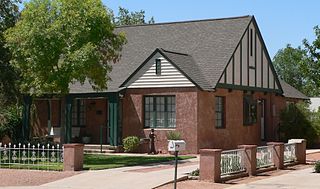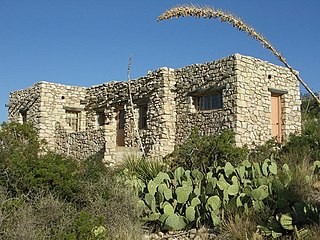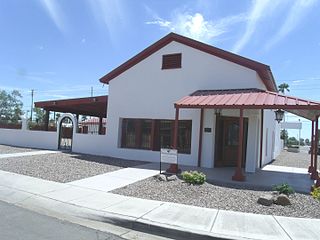
In the Southwestern United States, Pueblo (capitalized) refers to the Native tribes of Puebloans having fixed-location communities with permanent buildings which also are called pueblos (lowercased). The Spanish explorers of northern New Spain used the term pueblo to refer to permanent indigenous towns they found in the region, mainly in New Mexico and parts of Arizona, in the former province of Nuevo México. This term continued to be used to describe the communities housed in apartment structures built of stone, adobe mud, and other local material. The structures were usually multi-storied buildings surrounding an open plaza, with rooms accessible only through ladders raised/lowered by the inhabitants, thus protecting them from break-ins and unwanted guests. Larger pueblos were occupied by hundreds to thousands of Puebloan people. Various federally recognized tribes have traditionally resided in pueblos of such design. Later Pueblo Deco and modern Pueblo Revival architecture, which mixes elements of traditional Pueblo and Hispano design, has continued to be a popular architectural style in New Mexico. The term is now part of the proper name of some historical sites, such as Acoma Pueblo.

Hohokam was a culture in the North American Southwest in what is now part of Arizona, United States, and Sonora, Mexico. It existed between 300 and 1500 AD, with cultural precursors possibly as early as 300 BC. Archaeologists disagree about whether communities that practiced the culture were related or politically united. According to local oral tradition, Hohokam societies may be the ancestors of the historic Pima and Tohono O'odham peoples in Southern Arizona.

Casa Grande Ruins National Monument, in Coolidge, Arizona, just northeast of the city of Casa Grande, preserves a group of Hohokam structures dating to the Classic Period (1150–1450 CE).

Hubbell Trading Post National Historic Site is a historic site on Highway 191, north of Chambers, with an exhibit center in Ganado, Arizona. It is considered a meeting ground of two cultures between the Navajo and the settlers who came to the area to trade.

The Hohokam Pima National Monument is an ancient Hohokam village within the Gila River Indian Community, near present-day Sacaton, Arizona. The monument features the archaeological site Snaketown 30 miles (48 km) southeast of Phoenix, Arizona, designated a National Historic Landmark in 1964. The area was further protected by declaring it a national monument in 1972, and was listed on the National Register of Historic Places in 1974.

Pueblo Grande Ruin and Irrigation Sites are pre-Columbian archaeological sites and ruins, located in Phoenix, Arizona. They include a prehistoric platform mound and irrigation canals. The City of Phoenix manages these resources as the Pueblo Grande Museum Archaeological Park.

The National Park Service Southwest Regional Office, also known as National Park Service Region III Headquarters Building, is located at 1100 Old Santa Fe Trail in Santa Fe, New Mexico. The office provides support services for Park Service properties throughout the intermountain region of the American Southwest. The building, designed by NPS architect Cecil J. Doty, it is a traditional adobe building, built the 1930s by crews of the Civilian Conservation Corps. It is the largest adobe office building in the nation, and a masterpiece of Spanish Pueblo Revival architecture. It was designated a National Historic Landmark in 1987. It is open to the public during normal business hours; tours are not normally given.

This is a list of the National Register of Historic Places listings in Pinal County, Arizona.

The White House in Casa Grande in Pinal County, Arizona is a Tudor Revival house built c. 1929. It was listed on the National Register of Historic Places in 1985.

The Caverns Historic District comprises the central developed area of Carlsbad Caverns National Park. The complex was built between the early 1920s and 1942, initially in Pueblo Revival style, and later in New Mexico Territorial Revival style in the area around the natural entrance to Carlsbad Caverns. The earlier structures are built of local limestone, the later buildings in adobe. Thirteen buildings in the district are considered contributing structures. Buildings built between 1940 and 1942 were constructed with labor provided by the Civilian Conservation Corps.

Saint Anthony's Church is a Roman Catholic religious complex on Picacho Street in Casa Grande, Arizona. The church, along with the associated rectory, was listed in the National Register of Historic Places in 1985.

The Edward L. Jones House is a historic house at 5555 North Casa Blanca Drive in Paradise Valley, Arizona. It is a 2-acre (0.81 ha) property including a two-story adobe house, an adobe pump house, and an adobe and wood-frame barn. Built in 1932, the main house is a good example of Pueblo and Monterrey adobe revival styles, with walls of colored stucco and a multicolor tile roof. The roof eaves show exposed viga beams, and the windows are wooden casements, with wrought iron railings.

Johnston's Grocery Store, at 301 N. Picacho in Casa Grande, Arizona, is a historic building built around 1907. It was listed on the National Register of Historic Places in 1985.

La Casa del High Jinks is a historic house located on High Jinks Ranch in Pinal County, Arizona, southeast of the community of Oracle. The ranch was founded in 1912 by Buffalo Bill Cody, who ran a gold mine at the site. After Cody's death, the ranch was seized for unpaid taxes and subsequently sold to Lewis Claude Way. Way built the Pueblo style ranch house on the property, which he completed in 1928. The house is listed on the National Register of Historic Places.

Doyle Settlement was a ranch and settlement in Pueblo, Pueblo County, Colorado. It was listed on the National Register of Historic Places on April 4, 1980.

The Casa Grande Woman's Club Building, at 407 N. Sacaton Street in Casa Grande, Arizona, USA, is an historic women's club building which was listed on the National Register of Historic Places in 1979.

Los Luceros Hacienda, in Rio Arriba County, New Mexico near Los Luceros, New Mexico, is a historic site which was listed on the National Register of Historic Places in 1983. The hacienda property adjoins, or is close to, the Rio Grande. It is on a private road about .25 miles (0.40 km) off County Route 41

The Harvey-Niemeyer House, in Florence, Arizona, is a one-story house built around 1874. It was listed on the National Register of Historic Places in 1986, as a result of a study of historic resources in the Florence area.



















